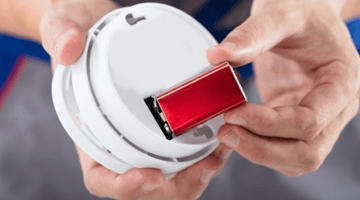Daylight Savings Time can be more than just a quick change of the clocks. Many use the “spring...
Spring Forward, Fall Back: Did You Check Batteries?

Daylight Savings Time can be more than just a quick change of the clocks. Many use the “spring forward” and “fall back” as much-needed safety reminders to check smoke detectors and carbon monoxide monitors.
Do you wait for the chirping of a low battery? If so, you know that it usually comes at a really inconvenient time.
Better to plan your detector checks with something as regular and well-publicized as the time change. It’s simple. When it’s time to change the clocks, it’s time to change the batteries in your detectors.
What Should I Know About Battery Operated Smoke Detectors?
Smoke detectors "live" by the credo, "where there's smoke there's fire," and every homeowner depends on them. The problem with smoke detectors is that, once they are installed, they are easy to forget. They make us feel safe, but quickly become part of the background. However, they save lives and should not be ignored.
- At the bare minimum you should have at least one smoke detector on every level of your home. For ideal safety, it is better to have one in each bedroom and in hallways.
- Most basic smoke detectors have a lifespan of eight to ten years. The 9-volt battery powered units are low-cost and popular, but the battery must be replaced every year.
- Smoke detectors that are hard-wired or use a 120-volt lithium battery last ten years, at which point you replace the whole unit.
Note: DC now requires all smoke detectors to be interconnected. They can all be wired on one circuit or they can be wirelessly interconnected (communicate via radio frequency). Most DC homes do not have interconnected smoke detectors on the same circuit. Consequently, if one detector senses smoke or carbon monoxide and sounds the alarm, the other detectors' alarms do not sound because there is no wiring connecting the detectors. With wireless interconnect detectors, if one alarm sounds, they all do.
What About Carbon Monoxide Detectors?
Carbon monoxide detectors function like smoke detectors but provide a life-saving signal if an elevated level of carbon monoxide is detected. Unlike smoke, carbon monoxide is undetectable to our human senses, even when we are awake. And it can be deadly.
- For minimal safety, you should install a monitor outside each sleeping area and on every floor with a gas appliance or attached garage. For added protection, they can be installed in your kitchen, basement, and at the entrance to an attached garage. They are most effective when placed about five feet above the ground.
- Good carbon monoxide detectors come with a ten year lithium battery and have to be replaced every ten years.
- You should also check the battery twice a year and test it regularly using the test/reset button. This will ensure the device is working correctly when you need it most.
Bottom line, smoke and carbon monoxide detectors are not “install and forget” devices. You need to stay on top of them and periodically check that they’re working properly. And while you’re focused on safety, consider taking a fresh look at the condition of your home’s electrical systems. If you have any questions or concerns, you should request an electrical safety assessment.
Wilcox Electric offers a value-priced Electrical Safety Assessment to identify, if present, the most common electrical hazards.



